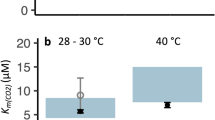Summary
Nitrogenase-produced H2 serves to remove excess intracellular O2 during vigorous growth periods (blooms) of the nuisance cyanobacterium Anabaena. In two naturally-occurring species, A. oscillarioides and A. spiroides, nitrogen fixation (acetylene reduction) showed a high degree of resistance to O2 inactivation. Under the influence of supersaturated O2 concentrations, commonly encountered in lake blooms, elevated cellular ATP levels and enhanced uptake hydrogenase and nitrogenase activities were observed in actively growing filaments. Oxygen enhancement of nitrogenase activity appears mediated through localized uptake hydrogenase reactions. Hydrogen assimilated by hydrogenase is combined with O2 in a “Knallgas” reaction, leading to the formation of H2O and ATP via a respiratory chain. This combination of activities appears poised at O2 removal and allows Anabaena to dominate O2 supersaturated surface waters while maintaining optimal nitrogenase activity. Hence, instead of being a wasteful dissipation of reducing power, H2 evolution via nitrogenase ultimately affords protection from O2 while constituting a source of ATP through subsequent H2 metabolism.
Similar content being viewed by others
References
Benemann JR, Weare NM (1974) Hydrogen evolution by nitrogen-fixing Anabaena cylindrica cultures. Science 184:174–175
Bothe H, Tennigkeit J, Eisbrenner G (1977) The utilization of molecular hydrogen by the blue-green alga Anabaena cylindrica. Arch Microbiol 14:43–49
Bothe H, Distler E, Eisbrenner G (1978) Hydrogen metabolism in bluegreen algae. Biochemie 60:277–289
Burnison BK (1980) Modified DMSO extraction for chlorophyll analysis of phytoplankton. J Fish Res Bd Canada 37:729–733
Dilworth MJ (1966) Acetylene reduction by nitrogen-fixing preparation from Clostridium pasteurianum. Biochim Biophys Acta 127:285–294
Dixon ROD (1972) Hydrogenase in legume root nodule bacteriods, occurrence and properties. Arch Mikrobiol 85:193–201
Frenkel A, Gaffron H, Battley EH (1949) Studies on H2 production by a photosynthetic bacterium. Biol Bull 97:269–277
Holm-Hansen O, Booth CR (1966) The measurement of adenosine triphosphate in the ocean and its ecological significance. Limnol Oceanogr 11:510–519
Hyndman LA, Burris RH, Wilson PW (1953) Properties of hydrogenase from Azotobacter vinelandii. J Bacteriol 65:522–531
Lim ST (1978) Determination of hydrogenase in free-living cultures of Rhizobium japonicum and energy efficiency of soybean nodules. Plant Physiol 32:609–611
Paerl HW (1978) Light-mediated recovery of N2-fixation in the blue-green algae Anabaena spp in O2-supersaturated waters. Oecologia (Berl) 32:135–139
Peterson RB, Wolk CP (1978) Localization of an uptake hydrogenase in Anabaena. Plant Physiol 61:688–691
Spiller H, Ernst A, Kerfin W, Böger P (1978) Increase and stabilization of photoproduction of hydrogen in Nostoc muscorum by photosynthetic electron transport inhibitors. Z Naturforsch 33:541–547
Stewart WDP, Fitzgerald CP, Burris RH (1967) In situ studies on N2 fixation using the acetylene reduction technique. Proc Natl Acad Sci USA 58:2071–2078
Stewart WDP, Pearson HW (1970) Effects of aerobic and anaerobic conditions on growth and metabolism of blue-green algae. Proc R Soc B 175:293–311
Tel-Or E, Luijk L, Packer L (1977) An inducible hydrogenase in cyanobacteria enhances N2 fixation. FEBS Letters 78:49–52
Tel-Or E, Luijk L, Packer L (1978) Hydrogenase in N2-fixing cyanobacteria. Arch Biochem Biophys 185:185–194
Author information
Authors and Affiliations
Rights and permissions
About this article
Cite this article
Paerl, H.W. Ecological rationale for H2 metabolism during aquatic blooms of the cyanobacterium Anabaena . Oecologia 47, 43–45 (1980). https://doi.org/10.1007/BF00541774
Received:
Issue Date:
DOI: https://doi.org/10.1007/BF00541774




